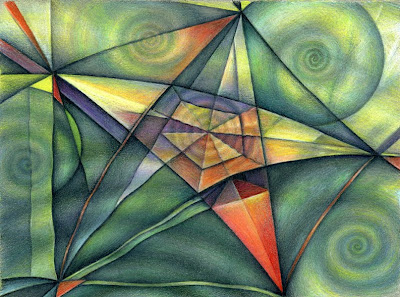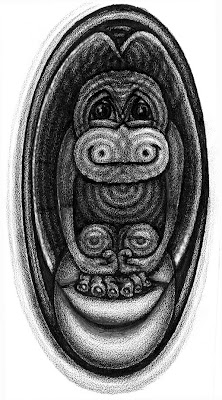
Thursday, December 24, 2009
Giving

Putting aside obligation, which changes the pleasure of everything, giving can be one of our most pleasurable experiences. Since the brain produces endorphins to reinforce behavior that’s good for our growth, the fact that endorphins are produced for giving underscores the importance of relationships that weave us into the fabric of humanity. It feels good to help others whether it’s giving a gift, or helping clear the snow off a car or even simply taking an interest in what they have to tell us. The pleasure is a message about our interconnectedness. Social isolation is a serious risk factor contributing to illness. Contributing to the good of the larger whole is good for us as well. Edgar Cayce used to say something to the effect that all of life is the body of god. Contributing to the well being of any part expresses our connection to the creative life force that links us all.
Showing appreciation for others fosters the health of the whole. Making a gift is a way of offering a symbol of the attention given to that person and ultimately attention is love. In whatever form it takes, attention is the greatest gift we have to offer. People feel seen and connected just through the act of response to them. It also liberates us from the competitive materialism that stains the holidays. (Negative attention is not really attention to the other but a projection of the mind from which it arises.)
When I had fewer relatives than I do now, I used to make each one a personal gift. Everything about the process was pleasurable, the time reflecting on the relationship, the particular person’s interests, the ongoing consciousness of giving from inception to completion of the gift and even the building of my skills and capacities. In the act of giving, the holiday itself is more alive with the awareness of offering something of myself rather than the mass-produced purchases that never seem personal.
Now with so many people in my life, though I make a few personal presents, each year I do bookmarks, drawings invented out of that year’s moods, that can be reproduced and laminated, and given to everyone. I get special pleasure out of bestowing them on people who would least expect it, who affected my life in some positive way even though I might not know them very well. It’s clear that I expect nothing in return, that it’s not a trade of presents, but an act of appreciation.
The fact that people have been reading what I’ve written here has been a tremendous encouragement. The motivation for writing this blog arises from the feeling that I may be able to offer some thoughts and a way of looking at things that could be helpful to others. So, to express my gratitude, this year one of my bookmarks is being offered to you, to print and laminate (I use clear contact paper on both sides) as thanks for your encouragement of my project.
Saturday, December 12, 2009
Connectedness
The theme of connectedness is emerging all around us. It’s not hard to see why.
Our shared environment is a conspicuous truth in the digital “noosphere”. That was a word that philosopher/ theologian Pierre Teilhard de Chardin used to refer to the atmosphere of consciousness in which we participate. He saw individuals as thinking molecules in this larger whole, contributing our perception to a larger inclusive awareness. The Internet mirrors this, is isomorphic in structure. Every individual mind is the hub of a wheel of connections and life experience that creates a personal viewpoint that influences and is influencing the whole. Similarly, in the physical world, just as we are always adjusting to our surroundings, our surroundings are always adjusting to us. I walk down the path and the birds fly off. Leaves and twigs are displaced by my steps and the air currents my presence initiates. Squirrels that know I have peanuts run toward me. There is no way of standing outside, and those are just the visible reverberations. Whenever new ideas start pouring from me. I say an inner thanks for the creative source for which I’m privileged to be a conduit. The role of the being I am with its accumulation of knowledge and unique perspective are the material that tune me to new meanings and are my language to communicate. Increasing my learning increases what is available to me to access, like familiarity with the music played in a concert can increase appreciation of the meaning given to it by the musician. I’ve heard my husband Michael play the same jazz standards uncountable times, but they still have the power to stop me, make me listen and sink into the expression he gives it at that moment. I Ching speaks of the holiness of music and its power “ to loosen the grip of the obscure emotions.”
There’s a purity to our connection with music. It can capture us. As Peter Gabriel said recently in an interview,” I love music because it plugs right into the emotions.” He felt it was more of the spirit than the other arts. John Dewey said, ”vision is a spectator, but hearing is a participant.” Vision can support the illusion of something outside of us, and we can choose to look the other way. Hearing seems to happen right inside us and is harder to shut out. It seems to merge with our personal awareness.
David Bohm used the word “artamovement” for the continuous act of “fitting” that is the essential quality of the whole. Rather than building blocks in the world machine, we are melodic lines in the symphony of consciousness. We fit what we have to offer into the structure unfolding around us like jazz improvises around the shape of the tune.
Thinking of many modes of vibration in harmony would be a better image to contemplate Bohm’s conception of individual elements as abstractions from an unbroken wholeness. The worldview that sees reality comprised of separate building blocks leaves us alienated. The emphasis on competition for resources creates opposition and antagonism. With an image of a deity outside of ourselves, this separation underlies everything. In a worldview that sees all as continuous movement in which we participate, we are naturally inclined to cooperate, to add our bit to the ongoing creation. Guided by the image of music, we try to blend with the group, work together, harmonize, fit what we have to offer into a larger whole. We feel a greater sense of responsibility toward each other and our environment when we feel like part of the same thing, the body of life, and the entirety of consciousness.
A Muslim reader wrote to me about how the Christian image of God could get in the way of seeing the deeper, more comprehensive view of the Spirit. Even images can begin to operate like labels, replacing the reality of a subject with the definition and dogma that builds up around the image/concept. “The Tao that can be told is not the eternal Tao.”
Just as Viktor Frankl concluded that the specific meanings are not as important as the search for meaning, we might be better off not clinging so tightly to the current images that emphasize separation and search for new images, lots of them, to help us reflect and gain access to the pleasure of our connection.
Our shared environment is a conspicuous truth in the digital “noosphere”. That was a word that philosopher/ theologian Pierre Teilhard de Chardin used to refer to the atmosphere of consciousness in which we participate. He saw individuals as thinking molecules in this larger whole, contributing our perception to a larger inclusive awareness. The Internet mirrors this, is isomorphic in structure. Every individual mind is the hub of a wheel of connections and life experience that creates a personal viewpoint that influences and is influencing the whole. Similarly, in the physical world, just as we are always adjusting to our surroundings, our surroundings are always adjusting to us. I walk down the path and the birds fly off. Leaves and twigs are displaced by my steps and the air currents my presence initiates. Squirrels that know I have peanuts run toward me. There is no way of standing outside, and those are just the visible reverberations. Whenever new ideas start pouring from me. I say an inner thanks for the creative source for which I’m privileged to be a conduit. The role of the being I am with its accumulation of knowledge and unique perspective are the material that tune me to new meanings and are my language to communicate. Increasing my learning increases what is available to me to access, like familiarity with the music played in a concert can increase appreciation of the meaning given to it by the musician. I’ve heard my husband Michael play the same jazz standards uncountable times, but they still have the power to stop me, make me listen and sink into the expression he gives it at that moment. I Ching speaks of the holiness of music and its power “ to loosen the grip of the obscure emotions.”
There’s a purity to our connection with music. It can capture us. As Peter Gabriel said recently in an interview,” I love music because it plugs right into the emotions.” He felt it was more of the spirit than the other arts. John Dewey said, ”vision is a spectator, but hearing is a participant.” Vision can support the illusion of something outside of us, and we can choose to look the other way. Hearing seems to happen right inside us and is harder to shut out. It seems to merge with our personal awareness.
David Bohm used the word “artamovement” for the continuous act of “fitting” that is the essential quality of the whole. Rather than building blocks in the world machine, we are melodic lines in the symphony of consciousness. We fit what we have to offer into the structure unfolding around us like jazz improvises around the shape of the tune.
Thinking of many modes of vibration in harmony would be a better image to contemplate Bohm’s conception of individual elements as abstractions from an unbroken wholeness. The worldview that sees reality comprised of separate building blocks leaves us alienated. The emphasis on competition for resources creates opposition and antagonism. With an image of a deity outside of ourselves, this separation underlies everything. In a worldview that sees all as continuous movement in which we participate, we are naturally inclined to cooperate, to add our bit to the ongoing creation. Guided by the image of music, we try to blend with the group, work together, harmonize, fit what we have to offer into a larger whole. We feel a greater sense of responsibility toward each other and our environment when we feel like part of the same thing, the body of life, and the entirety of consciousness.
A Muslim reader wrote to me about how the Christian image of God could get in the way of seeing the deeper, more comprehensive view of the Spirit. Even images can begin to operate like labels, replacing the reality of a subject with the definition and dogma that builds up around the image/concept. “The Tao that can be told is not the eternal Tao.”
Just as Viktor Frankl concluded that the specific meanings are not as important as the search for meaning, we might be better off not clinging so tightly to the current images that emphasize separation and search for new images, lots of them, to help us reflect and gain access to the pleasure of our connection.
Subscribe to:
Posts (Atom)
